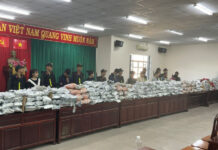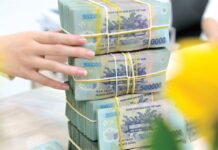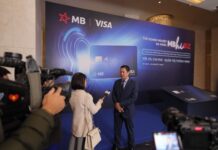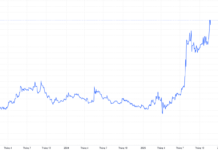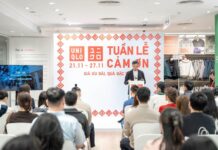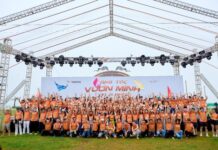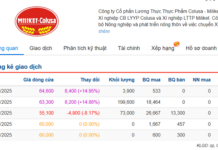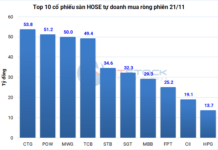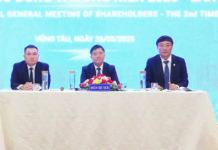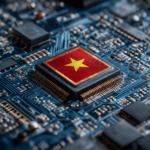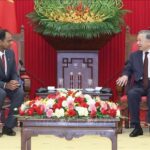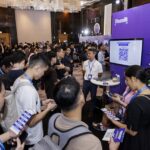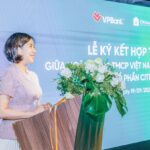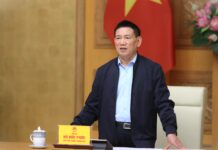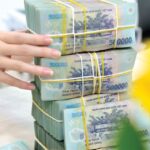The focus is on the semiconductor and artificial intelligence (AI) sectors, both of which are strategic technology industries gaining attention in Vietnam.
Experts believe Vietnam has a significant advantage in entering the semiconductor and AI fields due to its “golden population” and young, eager-to-learn workforce. However, Vietnamese labor productivity remains the lowest in the region, and the lack of soft skills among workers is a critical issue that needs addressing.
According to the International Labour Organization (ILO), Vietnam’s labor productivity is only one-tenth of Singapore’s and three-quarters of China’s. This growing development gap highlights the urgent need for transformative change.
This issue was a key topic of discussion among experts and speakers at the seminar titled “Promoting International Cooperation to Develop Human Resources, Infrastructure, and Breakthrough Policies for Strategic Technology Industries in Vietnam” held on the afternoon of October 2.
Mr. Tran Van Xuan, Founder and Chairman of Brain-Life Company, expressed his concern over Vietnam’s low labor productivity compared to the region. He questioned, “How are we stepping into a new era when one Singaporean worker is equivalent to ten Vietnamese workers? Where does that leave us in terms of competition?”
Mr. Xuan attributed the higher productivity of Singaporean workers not to greater diligence but to a better understanding of brain function and focus management. Vietnamese people, he noted, are inherently hardworking.
He shared a personal example from his time studying abroad: “French students would party until 5 a.m. but still score A’s on exams, while I studied tirelessly and only managed B’s.”
Mr. Xuan likened focus to a resource that must be managed and utilized effectively through three aspects: increasing focus capacity, enhancing engagement in tasks, and efficiently switching between focused and relaxed states.

Experts and speakers engaged in discussions at the seminar on October 2.
Many experts acknowledged that Vietnamese workers possess several outstanding strengths.
Mr. Vo Duc Thang, Chairman of the Vin Taiwan Network, shared: “Having studied, lived, and worked in Taiwan for 14 years, I’ve had extensive discussions with Taiwanese professors. They hold Vietnamese students in very high regard.“
In reality, Vietnamese students studying and researching in Taiwan achieve excellent results. Many go on to succeed in other countries as well. According to Mr. Thang, this talented workforce is Vietnam’s primary advantage in strategic technology industries.
Another advantage lies in cost-effectiveness. Mr. Tran Van Xuan noted that his foreign partners were surprised to see that with the same budget, Vietnam could move from prototype to market-ready product within 18 months, while other countries only managed to develop a prototype in the same timeframe.
Additionally, the Vietnamese government is implementing numerous policies to develop and attract human resources.
Mr. Ngo Tuan Anh, Chairman of the Innovation Network and Cybersecurity Expert (ViSecurity), highlighted that Vietnam is currently in its “golden population” phase with a strong appetite for learning.
Mr. Nguyen Thanh Tung, Vice Chairman of CMC Corporation and President of CMC University, agreed, adding that Vietnamese people excel in mathematics. This is crucial, as mathematics forms the foundation of AI and cybersecurity, two of the 11 strategic technology groups.
However, experts pointed out significant weaknesses in Vietnamese labor, including low work efficiency, inadequate soft skills, poor foreign language proficiency, weak teamwork, and insufficient specialized knowledge.
Mr. Tran Van Xuan also expressed concern about potential labor imbalances. The rush to focus on semiconductors and AI could lead to shortages in foundational industries like mechanics, chemistry, and materials.
How to Attract Talent in Strategic Technology Industries?

Experts discussed strategies for training and attracting talent in sectors like semiconductors and AI in Vietnam.
At the seminar, experts agreed that a major obstacle to developing human resources for strategic technology industries is the gap between theory and practice in Vietnam’s education system. For instance, while many universities aim for long-term internships for students, the actual costs for both schools and businesses become prohibitively high.
Mr. Nguyen Thanh Tung, President of CMC University, shared that each course at CMC University has around 600 students. Training is complex due to direct costs like venue, meals, and supervision. He suggested that practical training is essential but requires government policies to incentivize businesses, such as tax breaks, to motivate collaboration with universities.
Mr. Tung proposed that Vietnam study talent attraction models from other countries, such as China’s “red carpet” policy. This policy invites talented overseas Chinese, especially from the U.S. and Europe, with specific incentives.
He noted that many highly skilled Vietnamese are abroad, and creating attractive policies, environments, and opportunities is key to bringing them back.
Mr. Vo Duc Thang agreed, emphasizing the importance of connecting with the global Vietnamese intellectual community to build a network, train high-quality human resources, and attract talent back to Vietnam.
“I am eager to contribute to Vietnam’s journey in developing high-quality human resources,” Mr. Thang said.
Mr. Ngo Tuan Anh stressed that human resources are paramount, and educational reforms are needed to align education with practical needs, thereby improving labor productivity and efficiency. With a population of over 100 million, such reforms would significantly contribute to innovation, technological mastery, and socio-economic development in the new era.
Mr. Tran Van Xuan added that providing meaningful challenges for talent to contribute is essential.
Having lived abroad for 25 years, he advised, “Don’t wait for opportunities to come to you. View returning to Vietnam as an opportunity for personal growth.”
Vietnam has identified 11 strategic technology groups and products. According to the World Bank, investing in people is fundamental to driving science and technology.

Human resources are seen as the “golden key” to Vietnam’s development in sectors like semiconductors and AI. (Illustrative image)
At the event, Ms. Mariam J. Sherman, World Bank Country Director for Vietnam, noted that nearly 65% of Vietnam’s top technology talent in critical and emerging fields currently work abroad.
“Creating favorable conditions to attract this talent back will help Vietnam leapfrog, narrowing knowledge and network gaps that would otherwise take decades to build,” Ms. Sherman emphasized.
(Photo: MH/NIC)
The seminar was part of the National Innovation Forum 2025, held from October 1 to 3 at Hoa Lac Hi-Tech Park, Hanoi, organized by the Ministry of Science and Technology in collaboration with the Ministry of Finance.
Global Top 10 Conglomerate Powers Up Vietnam’s $100 Billion Economic Sector
Vietnam stands as the third-largest research and development (R&D) hub for this company globally, surpassed only by the United States and India.
Marvell Urged to Support Vietnam’s Data Center Development by General Secretary To Lam
On the afternoon of October 1st, at the Party Central Headquarters, General Secretary Tô Lâm received Mr. Sandeep Bharathi, Chairman of Marvell Global Group, USA. The General Secretary highlighted key priorities for Marvell to enhance its investment in Vietnam, including supporting the development of data centers, advancing the semiconductor industry, and training the workforce.
Vinamilk Saves $3 Million Annually with Self-Developed Order Management System
A seemingly simple process—verifying delivery photos—once cost Vinamilk over $3 million annually. Instead of scaling personnel or outsourcing, Vietnam’s leading FMCG company developed its own automated order coordination system. This innovation processes hundreds of thousands of images daily in mere minutes, marking a significant leap in the company’s digital transformation journey.
Revolutionizing Finance & Real Estate: Citics and VPBank Partner to Build a Digital Ecosystem
On September 19, 2025, in Hanoi, Citics Group Joint Stock Company (Citics) and Vietnam Prosperity Joint Stock Commercial Bank (VPBank) officially signed an expanded cooperation agreement, marking a strategic milestone in combining financial and banking strengths with real estate technology expertise.




